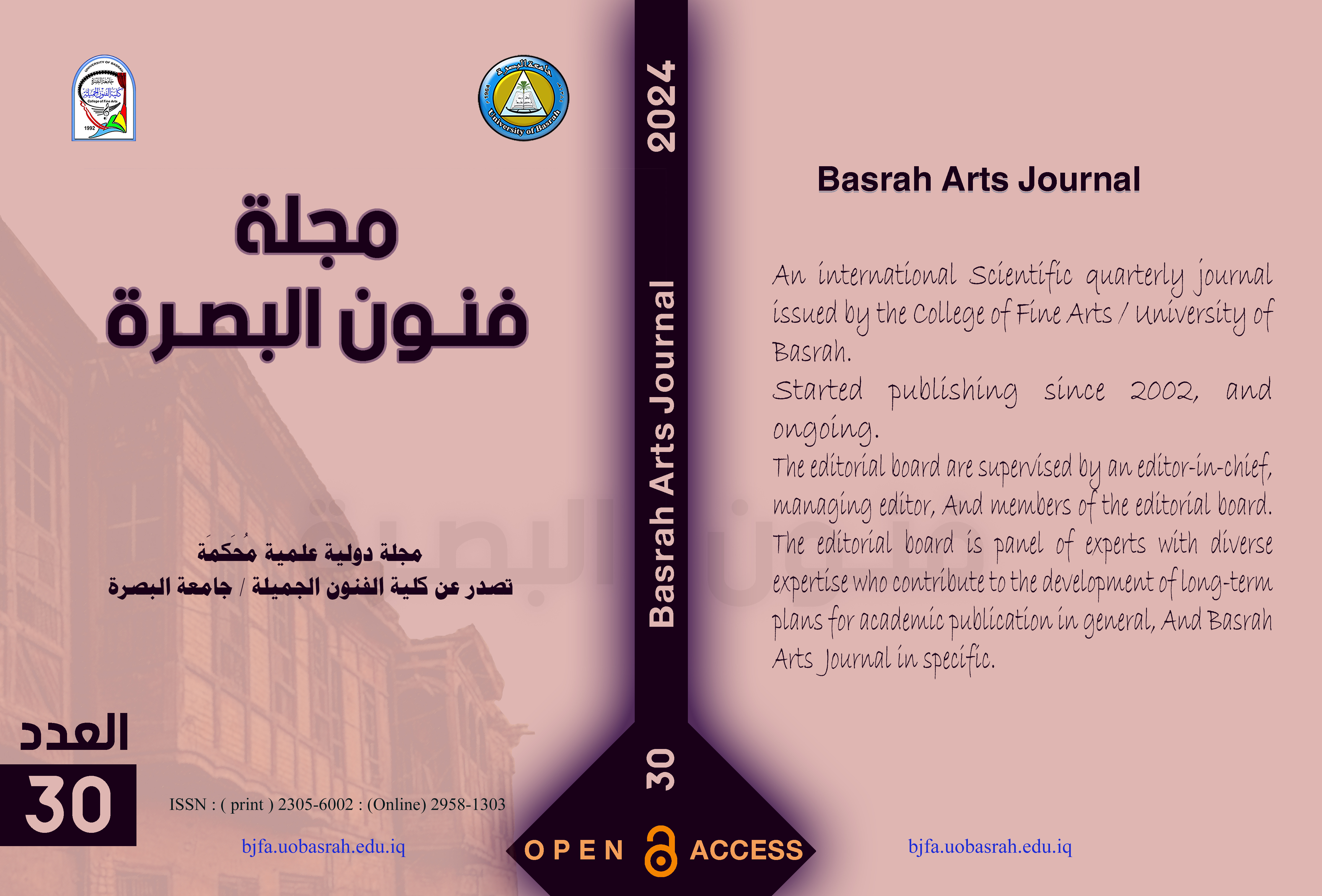Employing popular heritage in the Iraqi theatrical actor’s performance of the play
The Thread and the Bird” as an example
DOI:
https://doi.org/10.59767/2024.08/30.9Keywords:
employment, popular heritage, actor, performanceAbstract
In the history of Iraqi theater, popular heritage has always been a rich and abundant source of inspiration for artists. Heritage is considered an integral part of the cultural and social identity of the Iraqi people, as it carries within it values, traditions, and stories that constitute a large part of the collective consciousness. In this research, we will discuss how to employ popular heritage in the Iraqi theatrical actor’s performance of the play “The Thread and the Bird” as a model, as the actor aims to revive the heritage and present it in a way that is consistent with modern times, which helps to enhance cultural identity and connection to the roots, as popular heritage was used in the play The thread and the bird are touched in many ways, such as language, fashion, music, and dances. And motor performance. Through the above, the researcher will attempt to study this research in four chapters. The first chapter represents the methodological framework of the research problem around the following question: Was the Iraqi actor able to employ the popular heritage according to his motor and vocal tools in presenting the play The Thread and the Bird? Then the importance of the research and its goal through revealing and identifying the most important skills. The performance techniques that are compatible with the characters carrying the popular heritage in presenting the play The Thread and the Sparrow 0, then the limits of the research and definition of terminology. The second chapter, the theoretical framework, includes two sections: the first: the popular heritage (a historical view). The second section: the popular heritage and the performance of the theatrical actor, then what resulted from the theoretical framework. Of indicators, the third chapter includes procedures that include the research community, its sample, the research site, and sample analysis, then the fourth chapter includes results, conclusions, recommendations, and proposals, and the research concludes with sources Keywords: employment, popular heritage, actor’s performance.
References
A. D. (2006). Criticism of mythological and symbolic thought and symbols in human thought. Lebanon : Tripoli 0 Modern Book Foundation.
Abbas, z. ,. (1977). Once upon a time, glorification of action and solution (Vol. 14). Al-Aqlam Magazine.
Abdelkarim Bershid. (n.d.). Moroccan theater in the seventies (Vol. 1). 1982: Al-Aqlam Magazine.
AbuHaif, A. (2002). Contemporary Arab Theater Issues, Visions and Experiences. Damascus: Publications of the Arab Writers Union.
Al-Bakr, M. M. ( 2009). Field research in popular heritage, Damascus. Syrian : Ministry of Culture - Publications of the Syrian General Authority for Books.
Aldaghlawy, H. J. (2013). human rights & directing treatments in the Iraqi theatrical performance. Basrah, Iraq: University of Basrah. doi:http://dx.doi.org/10.5281/zenodo.7779863
Aldaghlawy, H. J. (2024). The aesthetics of forming acting performance in children's theater performances. Al-Academy(112), 209-222. doi:https://doi.org/10.35560/jcofarts1262
Aldaghlawy, H. J. (2024). Visual rhythm in the Iraqi theatrical performance. Journal of Arts and Cultural Studies, 3(1), 1-9. doi:https://doi.org/10.23112/acs24021201
Al-Gawhari, M. (1978). Folklore, a study in cultural anthropology, (Vol. 1). Cairo: Dar Al-Maaref.
Ali Al-Rai. ( 1979). Theater in the Arab World (Vol. 25). Kuwait: World of Knowledge Series.
Ali, H. A. (2003). Performance art skills in acting and social discourse, doctoral thesis, unpublished. Baghdad : University of Baghdad - College of Fine Arts - Department of Dramatic Arts.
Al-Mashhadani, D. (2002). The director’s options in formulating the theatrical performance. doctoral.
Aqeel, M. Y. ( 2000). Foundations of Theories of the Art of Acting. Lebanon : BeirutUnited New Book House.
Artaud, A. ( 1973). The Theater and its Companions, published by Samia Asaad. Cairo: Dar Al-Nahda Al-Arabiya.
Cole, T. ( 1997). and Helen Tarshi Shenoy: Actors and Acting - History of Acting, by Mamdouh Adwan, Damascus. Dramatic : Publications of the Ministry of Culture - Higher Institute of Dramatic Arts.
Counsell, C. (2011). Signs of Performance - Introduction to Twentieth Century Theater, by Amin Hussein Rabat, .
Dovento, J. (1976). The sociology of theater. study on collective shadows,.
I. A. (1990). Al-Mu’jam Al-Wasit. Beirut: Dar Al-Awaj.
Kazem, Z. (2010). The Abbasid Heritage and Its Impact on Arab Theater. Baghdad: Freedom Publishing House.
Qalaa , A. R. (2007). The Magic of Theater Footnotes on the Stage . Syrian : Damascus Publications of the Ministry of Culture - Syrian General Authority for Books.
Saad, S. (2001). The Ego - the Other, the duality of representational art. Kuwait: World of Knowledge Series (274.
Samir, S. (1989). Theater and Arab Heritage . Baghdad : House of General Cultural Affairs.
Sheldon, C. (n.d.). The History of Theater in Three Thousand Years. by Darni Khashaba.
Tabor, M. ( 2007). Weather and its effect on acting. Baghdad : Al-Fath Printing Office.
Wilson, J. ( 2000). The Psychology of Performing Arts, by Shaker Abdel Hamid. Kuwait: World of Knowledge Series (258).
Y. A.-N. (1989). Spot of Light - Spot of Shadow, articles on contemporary Iraqi theatre. Baghdad : House of General Cultural Affairs.
Downloads
Published
How to Cite
License
Copyright (c) 2024 Waad Abdul Amir Khalaf (Author)

This work is licensed under a Creative Commons Attribution 4.0 International License.







